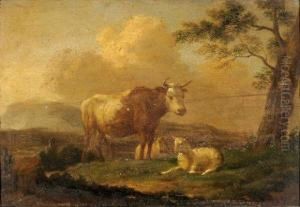P.B. Omeganck Paintings
Pieter Balthasar Bouttats, later known as Pieter Balthasar Omeganck, was a Belgian painter who specialized in landscapes and animal paintings. Born in Antwerp on January 20, 1778, Omeganck came from a family with artistic roots; his grandfather was the engraver Philip Bouttats the Younger, and his father was Balthasar Paul Omeganck, who was also a landscape painter.
Omeganck studied at the Royal Academy of Fine Arts in Antwerp, where he was a pupil of the landscape painter Hendrik de Cort. Throughout his career, he was heavily influenced by the 17th-century Dutch landscape tradition, often emulating the pastoral scenes and attention to naturalistic detail that characterized the work of Dutch masters. He is noted for his skill in depicting various textures, such as the wool of sheep or the foliage of trees, a talent that garnered him considerable acclaim during his lifetime.
In addition to landscapes, Omeganck was known for his animal paintings, particularly sheep, which were often the focal point of his compositions. His works are characterized by their serene and idyllic qualities, with a fine attention to lighting effects and atmospheric perspective. He achieved a sense of harmony in his paintings by carefully arranging the elements within his compositions, creating a balance between the natural world and the pastoral activities of the figures depicted.
Omeganck's contributions to art were recognized in his time, and he was a respected member of the art community. He was a member of several art societies, including the Royal Academy of Science, Letters and Fine Arts of Belgium. His work was exhibited in major cities such as Brussels, Ghent, and Antwerp, and he received numerous medals and honors for his contributions to the arts.
Omeganck passed away on January 18, 1855, in Antwerp. His legacy continued through his pupils, including Eugène Verboeckhoven, who became a well-known animaliere painter, and through his influence on later generations of landscape and animal painters. Today, Omeganck's works can be found in various museums and private collections, where they continue to be appreciated for their bucolic charm and technical mastery.
